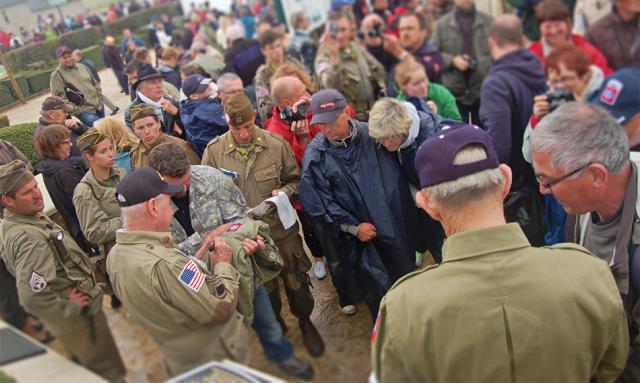
Amis des Vétérans Américains
Out on the hedgerow-stitched northwestern corner of France, the clock turns back each year to June 6, 1944, when Allied troops came by land, air and sea to liberate German-occupied Normandy and begin the long, bloody march to victory in the European theater of World War II.
Seventy years later, the narrow farm roads once again rattle under the wheels of green Army jeeps and half-tracks. Gray coastal skies are dotted with warplanes and parachutes. Men, women and children of all nationalities dress in vintage American uniforms, helmets and boots. They stroll past U.S. flags flying higher than any others, take in battle-scene re-enactments and wreath-laying ceremonies, traverse the legendary beaches and stand before the graves of heroes.
Nearly every village, town and city in the region conducts observances, parades, dinners and other events to memorialize the invasion that changed the course of history. Tens of thousands pour into Normandy each year to meet, get autographs and shake hands with D-Day veterans, most of whom are now in their 90s, and to pay respects to those who never made it home alive.
At the center of all this is an organization that for decades has welcomed U.S. veterans and their families, along with active-duty military personnel and American Legion officials. Amis des Vétérans Américains (Friends of American Veterans) is rooted in a spirit of French gratitude that extends back to a parade on the war-torn streets of Ste. Mère-Église on June 6, 1945, the first anniversary of the liberation.
As U.S. veterans began returning in larger numbers to Normandy, the need to provide housing, dinners, ceremonies and events grew. In the 1960s, with the publication of the best-selling book “The Longest Day” and the blockbuster movie based on it, the AVA and U.S. veterans organized “milestone-year” pilgrimages to Normandy for the 20th and 25th anniversaries. The visits became more frequent after parachutists – including many who jumped with the 82nd and 101st Airborne divisions during the war – began re-enacting the late-night air assault of 1944, a public spectacle that was started by the AVA and continues today.
On the 40th anniversary, Ronald Reagan became the first U.S. president to speak at a milestone anniversary of D-Day. His words about “the boys of Pointe du Hoc” are among the most remembered of his presidency. Following that, it became an expectation for world leaders to speak in Normandy on milestone years, a salute to the price paid in blood for freedom.
With the 70th anniversary this year, the AVA is welcoming American Legion National Commander Dan Dellinger and American Legion Auxiliary President Nancy Brown-Park for ceremonies in and around Ste. Mère-Église, the first town liberated in the invasion.
An AVA-produced Liberty Banquet on June 7 is already nearly sold out and will be attended by hundreds, including active-duty U.S. military units, and will feature music by the Holland, Mich., American Legion Band.
The AVA will also unveil a monument on the town square of Ste. Mère-Église, dedicated to Allied troops who gave their lives fighting behind enemy lines in the invasion. A major expansion of the Airborne Museum and a low-altitude parachute jump are also on the AVA agenda.
“We must never forget those young Americans, most of whom aged 20 years or younger, who gave their lives for our liberty,” says AVA President Maurice Renaud, whose father was the mayor of Ste. Mère-Église on D-Day and whose mother founded the AVA. “Each year, we are honored to host veterans and their families.”
The association recently developed a new website – www.avanormandie.org – where photos, stories, calendars and information about the association and the new monument can be found. The AVA is also on Facebook.
Follow Commander Dellinger’s official visit to Normandy for the 70th anniversary at www.legion.org during the first week of June.
Jeff Stoffer is director of The American Legion’s Media & Communications Division.
